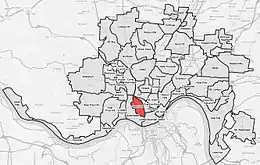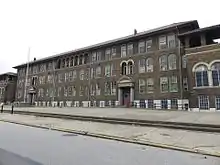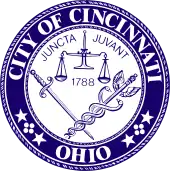West End, Cincinnati
West End is a neighborhood in Cincinnati, Ohio, located north-west of downtown, east of Queensgate, west of Over-the-Rhine, and south-east of Fairview. The population was 6,627 at the 2010 census.[1]

The historic West End was largely razed in the 1950s as part of a series of urban renewal projects, including the construction of Interstate 75.[2]
The West End is the location of City West, the largest housing development project in Cincinnati since World War II.[3] The project transformed the once low-income area into mixed-income development.[3] In 1999 many of the blighted, cramped buildings were leveled to make way for new townhomes with ample parking.[3] In 2007, part 1 crimes were down by 30% when compared to 1999.[3]
Controversy erupted in 2005 when plans were announced to open a $15-million "one-stop" social services facility at 800 Bank Street.[4] The project, known as CityLink, would be the largest such facility in Cincinnati.[5] Some argued that it would increase crime and poverty in the West End, decrease property value, and undermine the redevelopment there.[5] Some even accused the city of trying to relocate the poor from the thriving Over-the-Rhine neighborhood to the West End.[5] However, proponents argued that the West End's central location makes it easy for the poor to access.[5] A lawsuit to stop the CityLink project failed, as did the subsequent appeal to the Ohio Supreme Court.[4] CityLink Center has since launched in 2013, serving over 3,000 Cincinnati residents since that time including over 250 from the West End neighborhood. Individuals engage in the center to advance their lives holistically through the integrated support of over 14 on-site agencies. The development of CityLink Center has not resulted in crime, development has actually further continued, and property values have increased.
The West End is served by a branch of the Public Library of Cincinnati and Hamilton County.[6]
In 2021, FC Cincinnati of Major League Soccer will build a new soccer stadium in the neighborhood, at the site of Stargel Stadium on Central Parkway.[7]
Historic architecture and districts

- Laurel Homes
- Union Terminal, 1301 Western Ave
- Dayton Street Historic District
- Betts–Longworth Historic District
- Betts House, 416 Clark St
- Washburn School (Now Cincinnati College Preparatory Academy West), 1425 Linn St
- Former Lafayette-Bloom School, 1941 Baymiller St.
- The Regal Theatre, Clark and Linn Street
- The State Theatre, 1504 Central Ave
- St. Joseph's Catholic School, 745 Ezzard Charles Dr.
- Former Heberle Elementary School, 2009 Freeman Ave.
References
- "West End Statistical neighborhood approximation". City of Cincinnati. p. 2. Retrieved 27 January 2018.
- Gratz, Roberta Brandes (Sep 1, 1994). The Living City: How America's Cities Are Being Revitalized by Thinking Small in a Big Way. John Wiley & Sons. p. 70. ISBN 9780471144250. Retrieved 9 December 2013.
- Demeropolis, Tom (April 25, 2008). "City West project recreates West End". Business Courier of Cincinnati. Retrieved 2008-08-10.
- "Court decision go-ahead for Cincinnati's CityLink". Business Courier of Cincinnati. March 24, 2008. Retrieved 2008-08-10.
- Carter-Novotni, Stephen (2005-12-21). "CityLink Divides West End". Cincinnati CityBeat. Retrieved 2008-08-10.
- "West End Branch". Public Library of Cincinnati and Hamilton County. Retrieved 12 June 2014.
- Knight, Cameron (May 16, 2018). "Team, neighbors agree to benefit pact, then City Council gives its approval". The Cincinnati Enquirer. Retrieved May 29, 2018.
Further reading
Harshaw, J. W. (2009). Cincinnati's West End: Through our eyes. United States: CreateSpace.[1]
Singer, A. J. (2005). Stepping out in Cincinnati: Queen City Entertainment 1900-1960. Mount Pleasant, SC: Arcadia Publishing.[2]
External links
- Comprehensive West End Revitalization Plan
- Official CityLink site
- Ezzard Charles Drive, the Making of a Parkway
